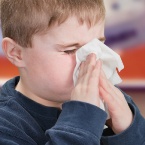We hope the following information that is put out by the AAP will you help make an informative decision about the flu shots or flu mist. To read the whole article click
here. Thanks to healthychildren.org for a great resource page. Please call us if you have any questions.
What is the flu?
The influenza (flu) virus causes serious illness that may result in hospitalization or death. It mostly affects the breathing system, but may also affect the whole body. The flu season usually starts in the fall and ends in the spring.
People can get the flu many times in their lives. Flu viruses are always changing over time and from year to year. Three seasonal flu viruses are expected to make children sick again this flu season.
Signs of the flu
All flu viruses cause a respiratory illness that can last a week or more. Flu symptoms include
- A sudden fever (usually above 101°F or 38.3°C)
- Chills and body shakes
- Headache, body aches, and being a lot more tired than usual
- Sore throat
- Dry, hacking cough
- Stuffy, runny nose
Some children may throw up (vomit) and have loose stools (
diarrhea). Talk with your child’s doctor if your child has ear pain, a cough that won’t go away, or a fever that won’t go away. There can be serious complications, even death, from the flu, but these are uncommon.
How to prevent the flu
Get the flu vaccine every year
Safe
vaccines are made each year to protect against the flu. This year’s flu vaccine protects against the same 3 strains of influenza virus in last year’s vaccine. These are
- Influenza A (H3N2)
- Influenza A (H1N1)
- Influenza B
The number of vaccine doses your child needs this year depends on his age at the time the first dose is given and his flu vaccine history.
- Children 6 months through 8 years of age should get 2 doses if they did not get a flu vaccine last year and 1 dose if they did.
- Children 9 years and older need only 1 dose.
Everyone should get the flu vaccine each year to update their protection because
- Protection from the flu vaccine lasts for about 6 to 12 months.
- The virus strains in the vaccine may change, so your protection usually needs updating.
Who should get which flu vaccine?
There are 2 types of flu vaccine.
Trivalent inactivated influenza vaccine (TIV) is given as a shot. There are 2 kinds of shots. The intramuscular (into the muscle) shot is licensed and recommended for children 6 months and older and adults, including people with and without chronic medical conditions. The new intradermal (into the skin) shot has been licensed for the 2011–2012 season to use in people 18 through 64 years of age.
Vaccination is especially important for people at higher risk of getting severely ill from the flu and their close contacts, the close contacts of healthy children younger than 5 years, all health care personnel, and all pregnant (or postpartum) women.
Live-attenuated influenza vaccine (LAIV) is sprayed into the nose. LAIV is recommended for healthy children 2 years and older.
Both types of flu vaccine are very safe and work well to protect your child from the flu. Check with your doctor about which is best for your child and family.
Are there side effects of the flu vaccine?
There are very few side effects of the flu vaccine. The area where the TIV flu shot is given may be sore for a day or two. Fever may occur within 24 hours after in about 10% to 35% of children younger than 2 years but rarely in older children and adults.
Because LAIV is sprayed into the nose, your child might get a stuffy, runny nose within the first few days. LAIV may produce mild symptoms, including rhinitis, headache, wheezing, vomiting, muscle aches, and fever.
You or your children will not get the flu from the vaccine. It takes 2 weeks for the vaccine to start working, so people can catch the flu before they are protected.
Is the flu vaccine safe for children with egg allergies?
In the past, children with egg allergies were not recommended to get the flu vaccine because they might have a reaction. There is now enough scientific information to show that influenza vaccine given in a single, age-appropriate dose is well received by nearly all children and adults who have egg allergy. Check with your doctor if you have any questions.
- Children with a history of mild egg allergy (hives) can get the flu vaccine safely at their doctor’s office.
- Children with a history of severe egg allergy should have their doctor consult with their allergist before getting the flu vaccine.
When should my child get the flu vaccine?
The best time to get the flu vaccine is the early fall or as soon as it is available in your community. If your child does not get the flu vaccine right away, it is still important to get it anytime. The flu virus infects people in the fall, winter, and well into the spring each year. Your child can still be protected if she gets a flu vaccine as late as March, April, or May. Ask your doctor if you have any questions about the flu vaccine.
Keep flu germs from spreading
The flu virus spreads easily through the air with coughing and sneezing, and through touching things like doorknobs or toys and then touching your eyes, nose, or mouth. Here are some tips that will help protect your family from getting sick.
- Everyone should wash their hands often. You can use soap and warm water for at least 20 seconds. That is about as long as singing the “Happy Birthday” song 2 times. And an alcohol-based hand cleanser or sanitizer works well too. Put enough on your hands to make them all wet, then rub them together until dry.
- Teach your child to cover his mouth and nose when coughing or sneezing. Show your child how to cough into the elbow or upper sleeve (not a hand) or use a tissue.
- Throw all tissues used for runny noses and sneezes in the trash right away.
- Wash dishes and utensils in hot, soapy water or the dishwasher.
- Don’t let children share pacifiers, cups, spoons, forks, washcloths, or towels without washing. Never share toothbrushes.
- Teach your child to try not to touch her eyes, nose, or mouth.
- Wash doorknobs, toilet handles, countertops, and even toys. Use a disinfectant wipe or a cloth with soap and hot water. (A disinfectant is a cleaner that kills germs.)
**info from Healthychildren.org
full article
here









